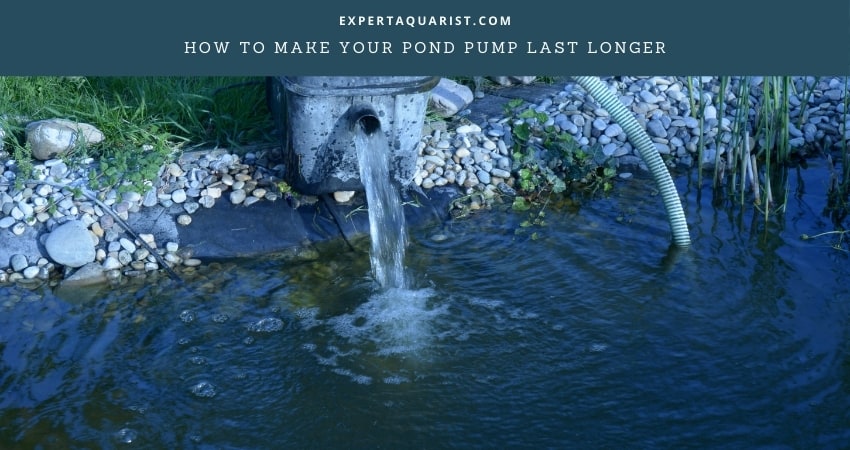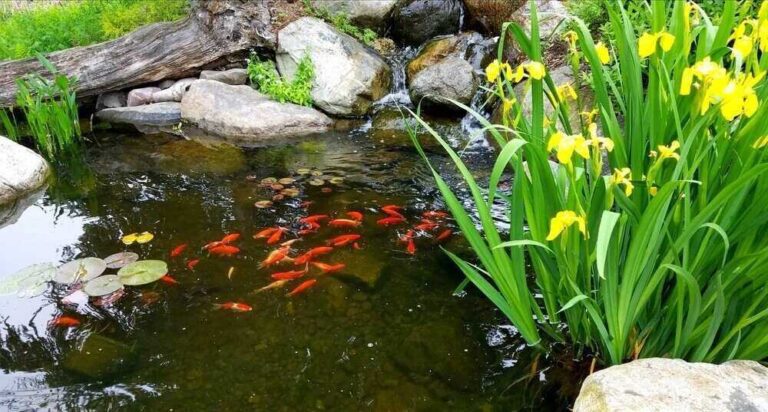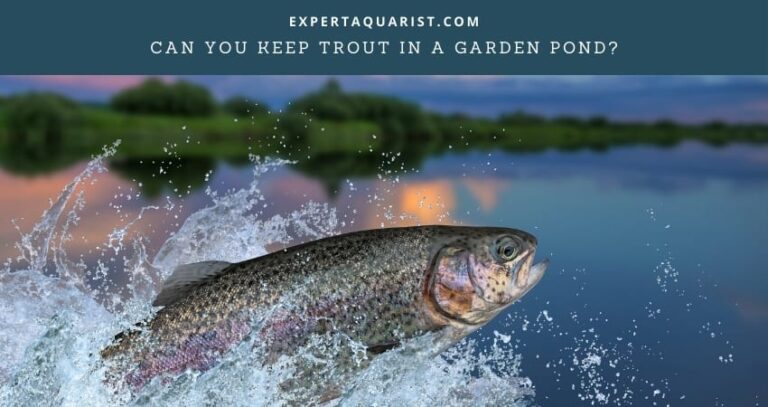Even before buying a pond pump, what people worry about is how long the pump is going to last? But forget to even think about what are the ways to maintain a pump.
How long a pond pump is going to last is more dependent on maintenance than the brand or company.
Pond pumps are very expensive to fix so you must know how you can make them last longer without spending a fortune on it. What you need to do to make sure your pump is durable in the long run is to check up on your pump on a regular basis.
Checking the impeller, the pre-filtration, and various electric cords connected to the pump regularly lets you find out and fix any issues immediately.
How can you improve the longevity of your pump?
Now that you have gathered enough knowledge about pumps and why pumps malfunction, let’s get into the most important part.
You can try the following methods to improve the lifespan of your pump and prevent it from unwanted issues. Obviously, these don’t guarantee the lifetime service of your pump, but by following these you can increase the durability of your pump.

1. Block or decrease dirt buildup
Always check your pump for any piled up dirt or debris. Even if debris is not everywhere and in a very little amount, still remove it all. Don’t let these accumulate because it’ll be hard for you later on as it builds up. Magnetic drive pumps are prone to this more than others because if dirt gets in between the walls and the impeller, it obstructs the movement of the pump.
2. Always clean the motor
It’s the fundamental key to keeping your pump fully functioning. There is no fixed time duration for cleaning motors, it mostly depends on various factors. Such as, filter quality, how often fishes are fed, water volume, amount of fish etc.
For example, A small pond with lots of fishes might need more regular cleaning than a big pond with less fishes. Then again it depends on water volume as well. So, what you need to do is be mindful about how your fish pond is and clean the motor accordingly.
3. Check your pump’s impeller frequently
Ensure the checking of the pump’s impeller once in a month or two. If you install a pre-filtration, it’s better for the impeller. By keeping the impeller clean you can extend the lifespan of the pond pump to a new extent.
Remember not to put your pump deep inside the bottom of your pond, rather try to keep it in a skimmer. But if you don’t have a skimmer, at least put it in a box with filtration. And clean the filters from time to time as well.
4. Safeguard your cords
It’s a very easy thing to do but guess what, most of the people forget to do so. They keep the cord open and it gets damaged causing the pump to stop working.
On the other hand, you should locate it in a secure place so people don’t accidentally get shocked by it.
You must have idea about the followings before you buy your pond pump
There are various reasons and factors on which the longevity of your pump depends. excluding general guidelines, maintenance tips and hacks, these are the two important factors you should keep in your head as soon as you plan to buy a pump.
1. Get The Pump Needed According to Your Pond
Start with selecting a powerful and good pump that is a perfect fit according to your pond’s specifications. Sometimes people have a large pond but they don’t get an adequately powerful pump, as a result it starts malfunctioning very soon.
While searching for the ideal pump for you, focus on how much water it will be pumping. The GPH (Gallons Per Hour) rating on the pump will clear this for you. GPH of a pump means how many gallons of water would the pump push in an hour.
And you should make sure the GPH of the pump is more or almost equivalent to how many gallons your pond is. In simpler words, your pump should be able to regulate water closer or more to the number of gallons of your pond.
Something else that should be taken into consideration is whether you have other features in your pond as well. Such as, waterfalls, additional filtration, fountains etc. If you have these, a pump with higher GPH is needed.
Because these put extra pressure on the pump and with lower GPH pumps it’s difficult to maintain the load. The heavier the pressure is on a pump, the shorter its lifespan.
Another considerable option that you can go for is submersible pumps. They are not very common or popular, but have their perks. Compared to all the others, submersible pumps are easiest to install, saving you time and money on installation.
Not just that, they also are quieter as the water blocks out most of the noise. As it stays underwater, it’s cleaner and dirt or leaves don’t get stuck on it. Allowing it to work more effortlessly for a long period of time.
2. General Idea about the Lifespan of a Pump
General pond pumps last around 2 years or so. You can’t expect it to run forever without any issues. Then again facing problems within a few months is not expected either. This happens when the pump has not been taken care of regularly.
On the other hand, high volume pumps have longer lifespan than the usual pond pumps. We find these kinds of pumps typically in swimming pools and large ponds. They can last up to a decade or more with proper maintenance.
Usually pumps rated GPH below five thousand only last around a year, while pumps rated more than five thousand GPH last more or less two years. Sewage pumps last the longest if you are wondering which pumps last the longest and then comes domestic grinder pumps lasting around four to five years on average.
Hopefully from this section, you will know what to expect from which kind of pump.
Most probable causes that might be destroying your pump
Though there are a lot of causes that might hamper the lifespan of a pump, some of the most common and blemishing reasons are included below.
1. Pressure on the pipes
One of the most common problems is the heavy strain on pipes due to inappropriate alignment of the flanges and suction pipe. Lucky for you it’s not a major issue at all. With the help of a wrench, you can fix this problem, but in some cases it’s a bit complex and expert help is needed.
2. Chemicals in the water
The water that’s been pumped doesn’t always have the same chemical properties. It varies from place to place. In some places water carries chemicals which are corrosive. Chlorine and chemicals like chlorine modifies the pH level and causes damage to the impeller. So, the pump starts malfunctioning.
pH factor, gravity viscosity etc. various fluid properties have different effects on the lifespan of your pond pump. Whether the water is acidic or corrosive impacts the parts of the impeller and the casing as well.
You need to check the water from time to time and also notice if you see any change in water color. Changes in color proves the entrance of unknown chemicals.
3. Pressure on the pump without regulation
The pump gets under intense pressure when it’s not powerful enough for the pond. As the pump has a lower GPH rating that it should have, it’s always under constant pressure.
Gradually different parts of the pump start showing various issues. Even before you realize anything, your pump is ruined already. It’s not repairable anymore or let’s say it is, you can buy a new motor with the repairing cost.
4. Oil Pollution
Most of the time, debris and small particles of dirt get in the way of oil lines. It contaminates the oil and without clean oil, the whole mechanism fails.
5. Misuse of the pump switch
Many users turn the switch on, and turn it off immediately. They repeat this now and then not realizing it is destroying the lifespan of the pump.
How do you clean your pump?
First and foremost, what you need to do is turn off the pump. Observe it before doing anything to assure current supply is off. You will need to take the pump out of water and take apart all the parts.
Remember which part was where before taking apart so you can put it back together again. When you are done disassembling, take out the impeller and clean it properly. Spray water at a higher speed at the impeller and all the debris and algae will be washed away.
Then notice if there is dirt stuck anywhere inside the pump. Using a sponge, scrub where necessary until the dirt gets off. And in no time your pump will be clean like new ready to be reassembled.
Put all the parts together as it’s instructed in the manual, and there you have your pump all cleaned up.
Additional Protection for your pump in Winter
You don’t need to worry about your pump during other seasons but in winter you should watch out for a few things. During winter snowing is inevitable but what is preventable is the damage. Here’s what you should do to prevent damage during winter.
Observe How Ice Forming
You don’t have any headache regarding the condition of your pump in normal temperature. But in winter when the temperature is below zero degrees, it becomes a matter of concern. Because ice starts building up.
As long as the ice keeps on building with consistency, just switch off the water supply and wait until it’s warm again. But unregulated ice forming might cause unwanted trouble like splashing water outside.
Provide warm water in the pond when necessary
In case of irregular freezing, you can easily prevent the water from turning into ice. Setting your hose in low-pressure mode, put it inside the pond. The water coming through the pipe is comparatively warmer than the water outside. As a result, a balance is created in overall water temperature which stops your pond from freezing over.
Final Words
A pump is expensive and you should be careful about how you deal with it. If you take care of your pump, it will be durable and provide good service throughout the year. And if you don’t, it will cause you trouble and money.
With the knowledge you gained from this article on how to make your pond pumps last, I believe you’ll gain much more value out of your investments.






